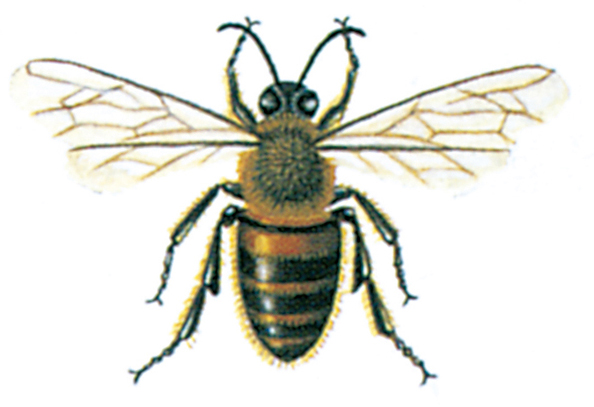(Latin: Apis mellifera)

This is one of the few, if not the only insect species to have become a true domestic animal. The ancient Egyptians had beehives some 5,000 years ago. The importance of honey bees as pollinators cannot be overestimated, and their honey has always been much sought after.
Honey bees live in colonies with a highly developed social organization, which go on from one year to the next. Each colony consists of a queen, a small number of males or drones, and a large number of workers, perhaps 10,000 to 20,000. As the central figure in the colony the queen is continuously fed and tended by• the workers, as she concentrates on the production of up to 2,000 eggs per day. The work carried out by the individual worker bees depends largely upon their age. The first couple of days after emergence from the pupal state are spent in cleaning the colony. This is followed by a period in which the workers tend and feed the larvae. After this they turn to a period of constructional work, producing wax from special glands on the underside of the abdomen which is used for building new cells, and they also look after the pollen and nectar brought into the colony. The latter part of their lives is occupied in foraging for food to support the colony.
From time to time the workers build a few special large cells in which they rear new queens. As honey bees have evolved the habit of having only one queen in each colony the old queen usually leaves the colony when a new one emerges. A number of the colony’s workers accompany her, forming what is known as a swarm, which founds a new colony.
A swarm is usually taken by a beekeeper who provides it with a hive, but if this does not happen the swarm will remain wild. Originally honey bees probably built their colonies in hollow trees, but nowadays a wild swarm may well establish itself in a cavity wall, provided there is suitable access.
The presence of a bee colony in such a situation is not necessarily a disadvantage. On bright sunny days there will be a fantastic amount of activity in and around the hole in the wall. Bees fly out and others return home, heavily laden with nectar and with big masses of pollen on their hind legs. A small number of bees are stationed at the entrance hole, keeping a continuous check on the traffic, and inspecting those that are returning to the colony. These are guard bees that ensure that only the true inmates of the colony are allowed to pass, and if necessary they can call up reinforcements.
The bees fly off in all directions, apparently at random, but this is not actually so. They can in fact tell one another where there is a rich source of nectar. When a foraging bee has found a good source, it returns to the hive and performs a special dance on one of the vertical frames that hold the wax cells. According to its form this dance can communicate to the other workers not only the direction in which they should fly but also the distance of the nectar source. The type of flower concerned is communicated by the scent which still clings to the finder.
A bee has to visit up to 1000 flowers in order to fill its crop with nectar, and on a sunny day it may make up to 10 foraging trips. The production of a pound of honey would require 20,000-30,000 trips.
When observing bees it is best to keep a few metres away and naturally not to stand in their line of flight. Even though modern bees by selection over many generations have become remarkably peaceful, they may occasionally become aggressive (p. 51) and attack humans.




